Types of precious orchids
Every Florist wants to add orchids to his collection. For the sake of beautiful flowers, lovers are ready to endure all the difficulties of care. There are orchids that have valuable leaves, they resemble precious stones. The precious orchid species are rare and only among collectors.
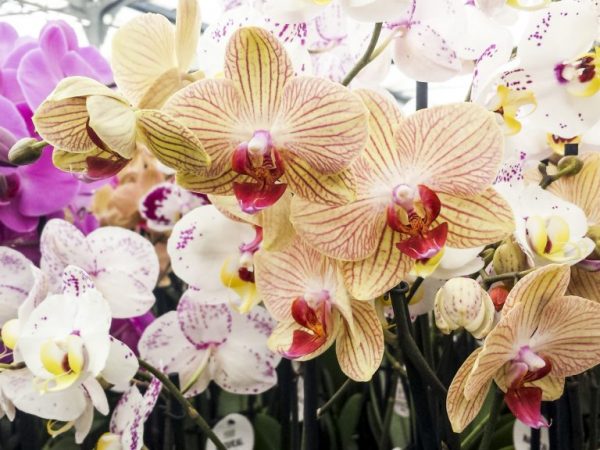
Types of precious orchids
Orchid species
Precious orchids get their name from the leaves, which combine velvety and a bizarre mesh pattern. The color of the leaves depends on the species and can be silver, light green, emerald, red, cherry and even black. The veins form laces of silvery, gold, copper and bronze threads. These plants have a second name variegated.
Plants of the precious family produce loose inflorescences with small white flowers and a pleasant delicate aroma.
In nature, there are more than 220 species of precious variegated orchids. Of these, only 6 can be grown at home:
- Ludisia;
- Makodes;
- Anectochilus;
- Dossinia;
- Zeuxine;
- Goodayer.
Ludisia
Flowers of the precious orchid of the genus Ludisia or Gemaria are widely popular among flower growers due to their unpretentiousness. In its natural environment, the plant has the shape of a bush and reaches 15 cm.On each branch there are no more than five velvety leaves with an olive or purple tint and shimmering light veins. They are approximately 4 cm wide and 7 cm long. On a high peduncle in winter, white flowers appear with a slight yellow tint on the column. They last for a long time. The strong rhizome is well developed. There are several varieties of Ludisias.
- Ludisia is colorless - reaches a height of 30 cm without peduncle. The leaves are red-brown with pink veins.
- Ludisia Odina has dark black-green leaves with silver veins.
- Ludisia Red Velvet has velvety leaves with pink stripes.
- Ludisia Green Corduroy has velvety dark green leaves with contrasting veins.
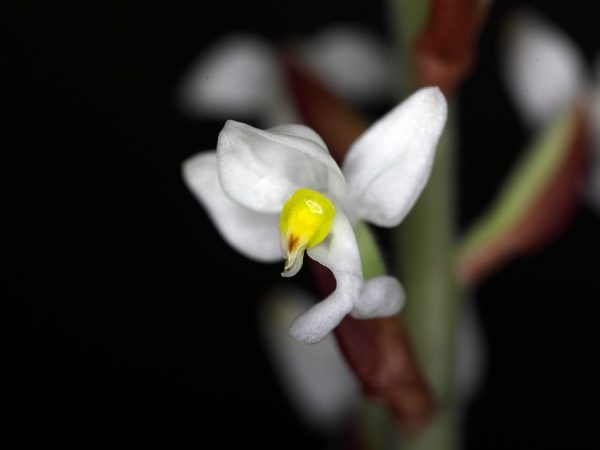
The precious Ludisia orchid is very popular
Makodes
The most popular type of precious orchid is Makodes petola. Its velvety leaves are 7.5 cm long and have a regular oval shape with a pointed edge. Light green, dark green, gray or emerald leaves are crossed by golden lace veins.
On high peduncles, petola appears no more than 20 white-brown nondescript flowers. After flowering, the rosette dies off and forms lateral shoots. When the soil is very dry, the plant sheds its leaves.
The lesser known Makodest Sandera is 15 cm tall and has large leaves, 15 cm long, with copper veins.
Dossinia
In home floriculture, the precious orchid of the genus Dossinia is represented only by the marble species. Plants grow up to 10 cm in height.Large, fleshy ovoid leaves with pointed tips have a rich olive color with a golden mesh of veins on the surface.
On a peduncle 30 cm high, brown flowers with a white lip appear.
Goodayera
A rare Gudayera plant grows up to 18 cm. Beautiful fleshy leaves are distinguished by a palette of green shades. The veins have no metallic sheen and are white, pink or blue. The sockets are kept for several years.
The most famous bristly Goodayera. Creeping, fluffy and reticulate are less common.
Anectochilus
The anectochilus orchid does not exceed 15 cm in height. The glossy surface of greenish-brown or green leaves of the regular egg-shape is densely covered with a network of golden or silvery veins resembling cracks.
The plant forms a dense rosette with a high inflorescence in the form of a lush brush with white flowers.
The most popular varieties are the Roxburgh Anectochilus, striped, handsome and royal. Less common is the Sikkim anectochilius. The hybrid of anectomaria deserves a place in the collection, which does not need a rest period and certain conditions.
Growing precious orchids
To grow exotic precious orchids at home, you should know the features of care. On the windowsill, only precious orchids from the genus Ludisia will delight you with flowering. The rest of the species are moisture-loving, so a florarium or a closed aquarium is suitable for breeding them.
Landing
Precious orchids are ground cover plants, in contact with the surface of the soil, the stems root on their own, therefore, shallow wide containers are used for planting. The holes in them should be located not only at the bottom, but also on the sides. For variegated plants, air access to the substrate is important. For Makodest Petola, you need a container of no more than 6 cm.
Growing precious orchids with seeds at home is almost impossible.
Reproduction
Reproduction of precious orchids takes place with the help of shoots. When five leaves and four internodes appear, a root appears under the first leaf. As soon as two leaves grow under the place of root formation, and above two internodes, the shoot is cut off for rooting. The place of the cut is sprinkled with charcoal and placed in a special substrate for the Orchid genus. The shoot takes root and grows quickly.
Line the bottom of the pot with a layer of drainage, no more than 3 cm thick. Fill the container halfway with the substrate and place it in water for 2 hours. Add potassium permanent for disinfection.
In water, using a sharp knife, cut off all dry and rotten roots. Sprinkle the slices with activated charcoal and dry. Place the rhizome in a new container and sprinkle with fresh substrate. To distribute the soil evenly, shake the pot. Cover the top layer with moss, pre-soaked for 1.5 hours in warm water. Remove the transplanted plant for 5 days in a warm, constant humidity, draft-free place.
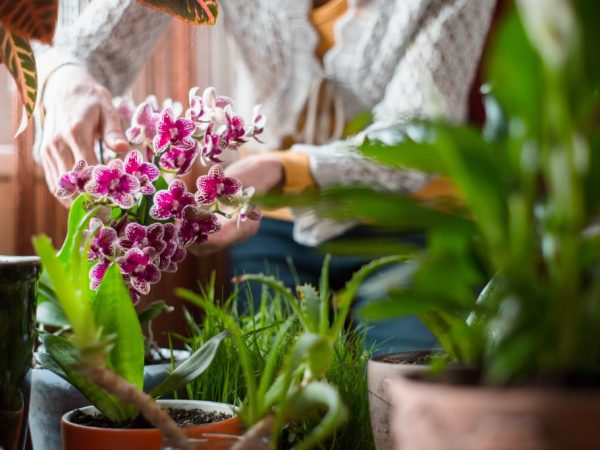
To grow exotic precious orchids at home, you should know the features of care
The soil
Substrate for precious orchids must be moisture and air permeable. Consists of moss, leafy soil, pieces of pine bark and charcoal, coarse sand and perlite. For disinfection and softening, moss and pieces of bark must be soaked in boiling water. After planting the orchid, the soil surface is covered with sphagnum moss.
Bloom
Blooming of precious orchids occurs in the autumn-winter period. In young plants, it is recommended to remove peduncles, because during flowering, the stem lengthens, and the lower leaves give off nutrients and die off. After flowering, the growth of the plant stops for a while.
Lighting
Precious plants are representatives of the tropics, therefore they are shade-tolerant.Florists recommend finding a place in the apartment where direct sunlight does not fall, for example, windows facing north, west or east. Makodes and goodiera grow well under twelve-hour artificial lighting, the distance from the phytolamp should be at least 30 cm. They are grown in shaded areas or in the bathroom. Lack of light leads to stretching of the plants and the formation of a large space between the leaves. In good light, the plants will be squat with small stems and internodes.
Temperature regime
Orchids of precious varieties thrive at room temperature. However, they do not tolerate cold snaps up to 18 ° C and tolerate heat very well. Lowering the temperature leads to premature flowering and loss of decorative leaves.
Peduncles will last longer if the temperature is maintained within 20C during the flowering period.
Orchids of the genus Ludisia prefer to lower the night temperature by 4 ° C.
After flowering, anectochilius needs a dormant period, for this it is recommended to reduce the temperature by 2-4 ° C for the winter.
Watering and humidity
In caring for precious orchids, watering and air humidity are important components. These plants require intensive watering at short intervals. Do not allow the soil to dry out, even in the middle part. Plants grow well with a constant medium-high substrate moisture. Watering is carried out either by the classical method, or by saturating the soil when immersed in water. To prevent moisture from stagnating, you need to fill the pot by a third with drainage - pieces of foam or expanded clay. To remove salts, it is recommended to boil or filter the water, preferably using melt and rain water.
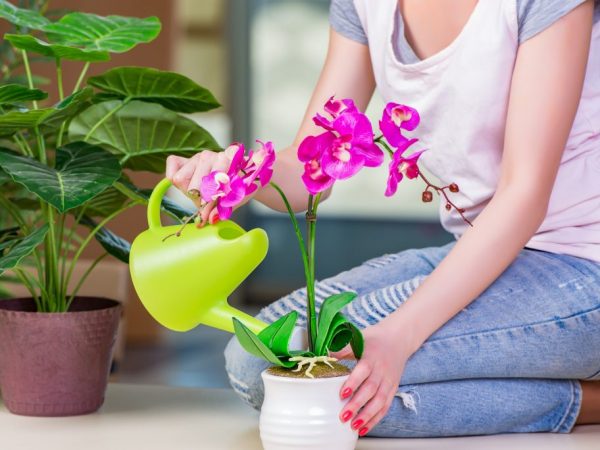
Orchids require intensive watering at short intervals.
In the florarium, the humidity of the air increases due to evaporation from the soil, therefore watering is carried out once a week.
In cold weather, watering is adjusted as the soil dries out, and for anectochilius, it is halved.
Fertilizer
Fertilizers for precious orchids are applied along with water during irrigation. A similar procedure is recommended to be carried out in spring and summer once every 3 weeks, and in the cold season, once every 5 weeks. The recommended dose is advised to be divided into three times and applied gradually, this optimizes the accumulation of nutrients and promotes the formation of effective greenery.
Diseases and pests
Diseases
Precious orchids are susceptible to disease. Uncontrolled development of moss will lead to stem rot. They fight it only with the help of an urgent transplant with scalding the soil. To combat fungal infections, the affected leaves are removed and the cuts are treated with crushed coal.
Lack of moisture leads to wrinkling of leaves and shoots. With a sunburn, a local spot is formed.
Pests
When the moisture content of precious plants is disturbed, a spider mite appears on the leaves. The plant should be thoroughly treated with alcohol, turpentine or finely chopped garlic and onions.
Mealybug infection is manifested by the formation of off-white fluffy lumps on the plant. It is recommended to treat it with ethyl alcohol, neem tea tree oil, garlic gruel and place the plant in a tightly tied bag for a couple of days.
Blackening of the soil and reddening of the tissues around the pests indicate scab infection. The plant is treated with alcohol, machine oil, vinegar or kerosene and washed off after 3 hours.
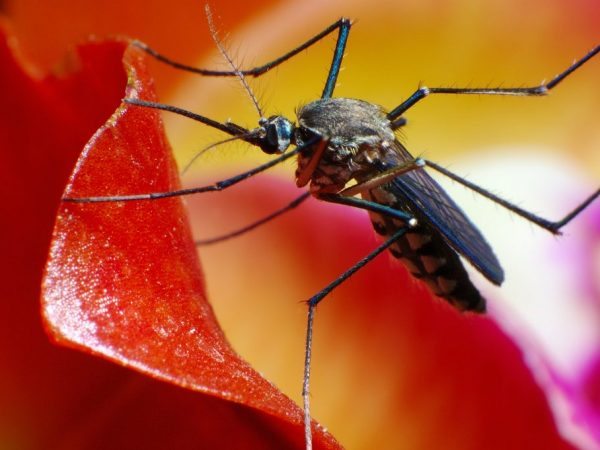
Pest control methods
Whitefly attack is manifested by the laying of eggs and the formation of a sticky coating on the inside of the leaves. In the fight against it, use sticky tape for flies and rinse thoroughly under running warm water.
Aphid infestation is characterized by the formation of whitish scales, discoloration and leaf fall.It is recommended to spray the plants every day with an infusion of pungent-smelling herbs, for example, tobacco crumbs, needles, citrus peels, onions or garlic.
When using self-prepared soil, there is a risk of contamination of plants with nematodes, snails and slugs. They lead to infection of the stem. To combat this problem, the shoots are cut and the cuts are processed, followed by transplantation.
Prophylaxis
In order to avoid infection with diseases and attacks of pests, preventive measures should be taken.
- The acquired plants should be quarantined for at least 10 days.
- Avoid large clusters of plants on the windowsill.
- Observe the temperature regime and soil moisture.
- Ventilate the area regularly to avoid damage during transplantation.
- Choose soil and fertilizers carefully.
- Use sterile pots and tools.
Conclusion
With proper care, indoor precious orchids will delight you with their unusual appearance for a long time and will become a wonderful decoration for any room.


